Critical Care, Toxicology, and Wound Management
1/168
Earn XP
Description and Tags
For Chapter 27
Name | Mastery | Learn | Test | Matching | Spaced |
|---|
No study sessions yet.
169 Terms
A wound dressing that is a primary layer impermeable to moisture
Occlusive
Wound caused by pressure on skin over bony prominences
Decubitus Ulcer
Cells recruited into a wound during the proliferative phase that help form granulation tissue
Fibroblasts
Sharps cut or tear of skin
Laceration
Having an affinity for water
Hydrophilic
Wound healing involving treatment that does not allow the wound to dry out
Moist
A primary wound dressing that allows air and moisture to move through
Semiocclusive
Closure of wound by apposing the skin over healthy granulation tissue
Secondary
Healing of a wound across a surgically closed incision
Primary Intention
The opposite side
Contraiateral
Vascularized fibrous tissue that covers a wound if left to heal by second intention
Granulation
Tissue also known as proud flesh
Exuberant Granulation
Healing of a wound by granulation tissue formation, epithelialization and contraction
Second Intention
Pertaining to the groin area
Inguinal
Type of injury that features a large section of skin torn off the underlying tissue in a glove-like fashion
Degloving
Having an osmotic pressure equivalent to that of blood plasma
Isotonic
Having an osmotic pressure greater than that of blood plasma
Hypertonic
Surgical closure of a wound
Primary
Meshwork-like substance in a wound, attached to the outer cell surface that provides support and anchorage
Extracellular Matrix
Space between tissues allowing accumulation of fluid
Dead Space
A cell with contractile properties that is responsible for wound contraction
Myofibroblast
Removal of foreign matter and dead tissue from a wound
Debridement
The process in which skin cells advance in a single layer across the wound
Epithelialization
Wound healing by secondary closure after allowing granulation tissue to form
Third intention
A tefton is one example of this type of wound dressing.
Nonadherent
Deposited into a wound by fibroblasts during the proliferative phase of healing
Collagen
An area of skin that has been superficcially scraped
Abrasion
A wound with a high bacterial count
Dirty and infected wound
Surgical wound that enters the GI tract
Clean-contaminated wound
Surgical wound
Clean wound
An open traumatic wound
Contaminated wound
An old traumatic wound
Dirty and infected wound
A surgical wound with a minor break in sterile technique
Clean-cotaminated wound
A surgical wound into the respiratory tract
Clean-cotaminated wound
A natural wound with minor contamination
Contaminated wound
A surgical wound with a major break in sterile technique
Contaminated wound
Carpal Flexion Sling
Used for the forelimb in any situation where weight-bearing should be avoided but some movement of the elbow and shoulder joints is acceptable
Cast
A device used to immobilize fractures that is most often made of fiberglass material
Ehmer Sling
A device that prevents weight-bearing of the pelvic limb; frequently used after closed reduction of craniodorsal hip luxations
Modified Thomas Splint
A traction splint constructed of rods used for stabilizing long bone fractures in large animals
Modified Robert Jones Bandage
The most commonly used distal limb bandage in small animals; also known as a soft-padded bandage.
Robert Jones Bandage
A very bulky bandage used to immobilize distal to the elbow or stifle joint
Schroeder-Thomas Splint
An immobilization device with a rigid metal frame (no longer recommeded)
Spica Splint
Maintains the limb in extension; includes a lateral splint that reaches over the shoulder or hip
Velpeau Sling
A device that prevents weight-bearing of the thoracic limb; primarily used after reduction of medial shoulder luxations
90/90 Flexion Sling
Used in puppies after repair of distal femoral fractures to prevent quadriceps tr-down or contracture
Hobbles
Prevents abduction of the pelvic limbs; primarily used after reduction of ventral hop luxations
No closure of a wound with to ______.
Second Intention Healing
Primary closure of a wound will lead to _______.
Primary Intention Healing
Secondary closure of a wound will lead to ______.
Third Intention Healing
First-degree Burn
Skin is red and painful
Second-degree Burn
Skin may appear yellow-white, black, or charred
Third-degree Burn
Skin that is thick, leathery, and oten black
Fourth-degree Burn
A burn that involves tissues deep to the skin
Elastikon Elastic Adhesive Tape (Johnson & Johnson Medical, Arlington, TX)
Tertiary layer
Curagel Hydrogel (Kendall/Covidien, Mansfield, MA)
Primary layer nonadherent semiocclusive
Cotton Sheets
Secondary layer
NU-GEL Hydrogel (Johnson & Johnson Medical, Arlington, TX)
Primary layer nonadherent occlusive
Cast Padding (3M Skin and Wound Care, St. Paul, MN)
Secondary layer
20% Sodium Chloride Dressing
Primary layer hypertonic or hyperosmolar
Vetrap Electric Bandage (3M Animal Care Products, St. Paul, MN)
Tertiary layer
Hydrosorb Plus Foam (Kendall/Cpvidien, Mansfield, MA)
Primary layer nonadherent semiocclusive
Military Field Bandage
Secondary layer
Petrolatum-impregnated Gauze
Primary layer nonadherent nonocclusive
Ultec Hydrocolloid Dressing (Kendall/Covidien, Mansfield, MA)
Primary layer nonadherent semiocclusive
Flannel Tracj Wrap
Tertiary layer
King Conforming Gauze (Johnson & Johnson Medical, Arlington, TX)
Tertiary layer
Honey
Primary layer hypertonic or hyperosmolar
Bioclusive Polyurethane Film (Johnson & Johnson Medical, Arlington, TX)
Primary layer nonadherent semiocclusive
Rooled Cotton (Johnson & Johnson Medical, Arlington, TX)
Secondary layer
Tefton Pads
Primary layer nonadherent nonocclusive
Tegaderm Transparent Dressing (3M Skin and Wound Care, St. paul, MN)
Primary layer nonadherent occlusive
Quitted Leg Wraps
Secondary layer
Sterile Wide-mesh Gauze
Primary layer adherent
Tegaderm Hydrocolloid (3M Skin and Wound Care, St. Paul, MN)
Primary layer nonadherent occlusive
Ace Bandage
Tertiary layer
Granulated Sugar
Primary layer hypertonic or hyperosmolar
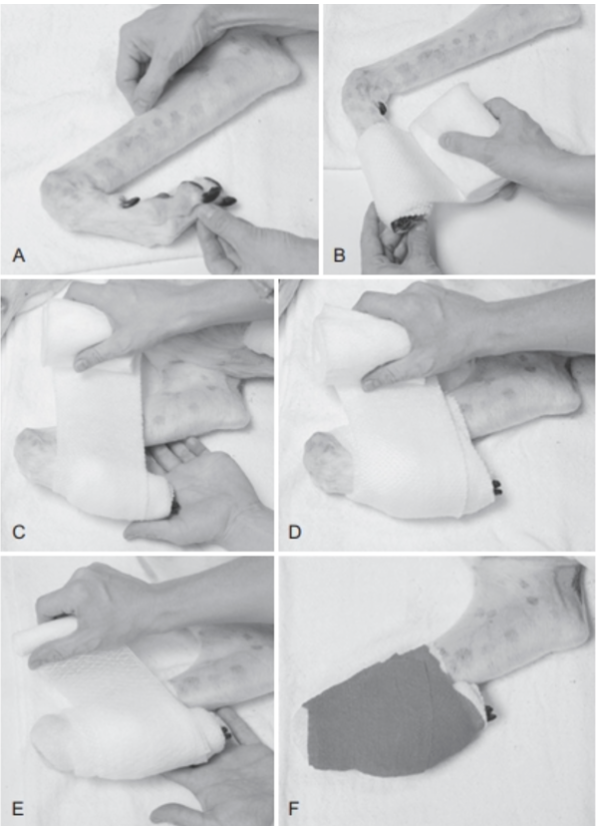
Name and primary indication(s):
Carpal Flexion Sling
A carpal flexion sling can be used in any situation where weight bearing should be avoided, but some movement of the elbow and shoulder joints is acceptable. It can be used to relieve tension on the carpal flexor tendons after injury or surgical repair.
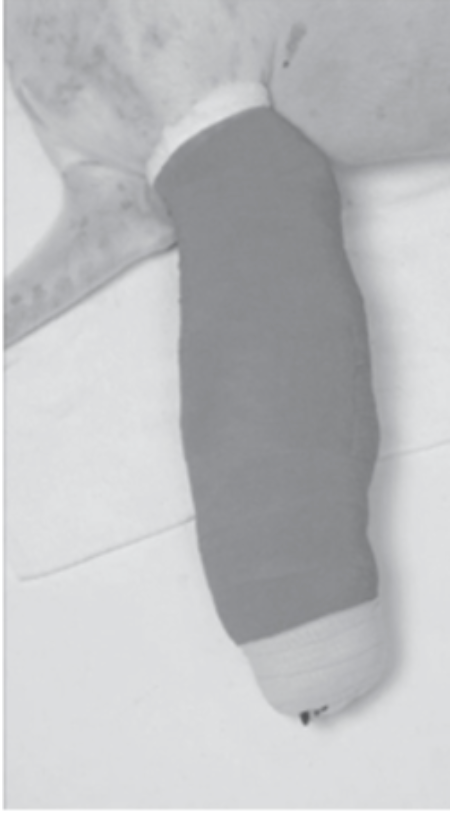
Name and primary indication(s):
Robert Jones Bandage
The Robert Jones bandage can be used to temporarily immobilize a limb distal to the elbow or stifle joint.

Name and primary indication(s):
Valpeau Sling
The Velpeau sling is a non-weight-bearing sling for the forelimb used to immobilize all joints of the affected leg. It is mainly applied after reduction of medial shoulder joint luxation of ater reconstruction of tenuous fractures.
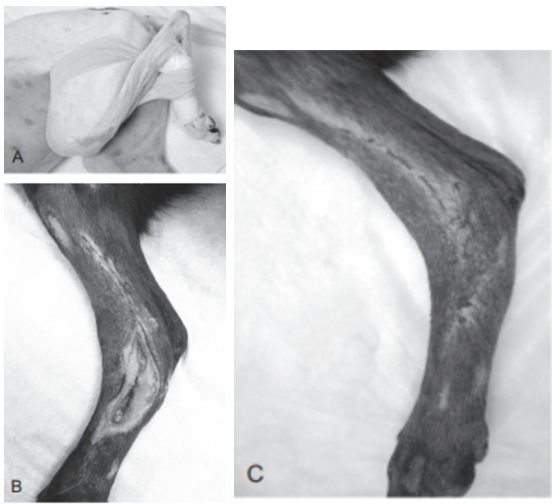
Name and primary indication(s):
Ehmer Sling
An Ehmar sling is a non-weight-bearing sling applied to the pelvic limb to protect the hip after injury. It is used primarily after closed reduction of craniodorsal hip luxation and electively after surgery associated with the coxofemoral joint.
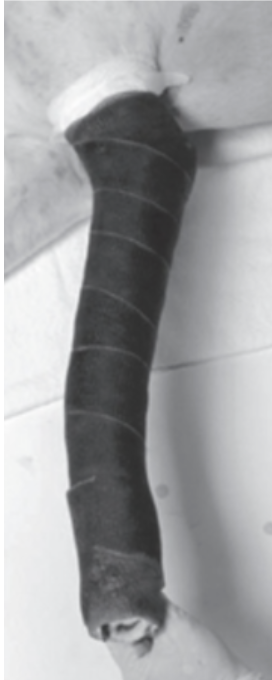
Name and primary indication(s):
Fiberless Cast
Casts are used to provide stability for joint injuries or fractures either for temporary support until surgery; as a means of definitive treatment, or as an adjunct after surgical stabilization.
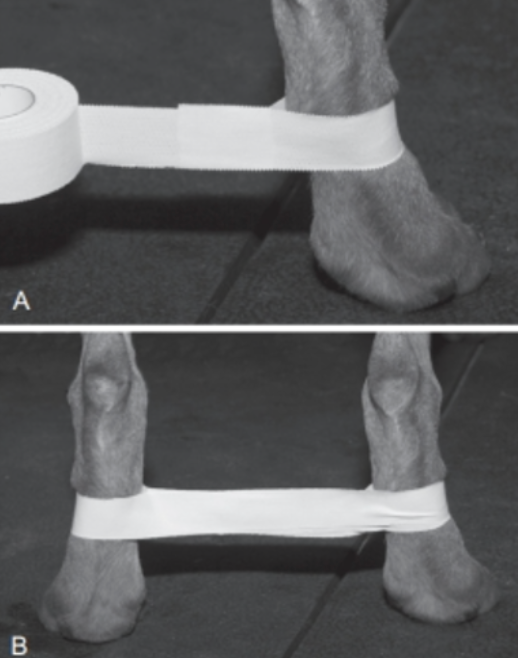
Name and primary indication(s):
Hobbles
Hobbles prevent abduction of the pelvic limbs and are used after reduction or ventral hip luxation.

Name and primary indication(s):
Modified Robert Jones Bandage
The modified Robert Jones bandage is the most commonly applied distal limb bandage in small animals. It uses a much thinner secondary layer and often is referred to as a soft-padded bandage. Because less padding is used, the tertiary layer must not be overly tight, or pressure necrosis may occur. Splints and casts can easily be incorporated into the bandage.
Place the steps of applying a cast to a horse’s limb in the appropriate order for Step 1 in the space provided.
A. ____ Collect all necessary materials.
B. ____ Place wire traction loops, if using, through the hoof.
C. ____ Apply two to three layers of 4-to 5-inch fiberglass material.
D. ____ Induce general anesthesia.
E. ____ Cover the limb with a double layer of stockinette.
F. ____ Clean the sole, remove the shoe, and trim the hoof.
G. ____ Place a wooden wedge underneath the heel.
H. ____ Dry the skin and powder it with talcum or boric acid.
I. ____ Apply two layers of 3-inch plaster material.
J. ____ Cut off the excess stockinette, leaving about 4 cm, and incorporate this into the last layer of the cast.
K. ____ Protect the bottom of the cast with hard acrylic.
L. ____ Apply orthopedic felt at points of pressure.
M. ____ Cut the traction wires, if used, and have an assistant support the leg.
N. ____ Apply support foam.
O. ____ Apply fiberglass material by overlapping one third to one half of its width as it’s applied.
P. ____ Place adhesive tape around the top of the cast and attach it to the skin.
Collect all necessary materials
Place the steps of applying a cast to a horse’s limb in the appropriate order for Step 2 in the space provided.
A. ____ Collect all necessary materials.
B. ____ Place wire traction loops, if using, through the hoof.
C. ____ Apply two to three layers of 4-to 5-inch fiberglass material.
D. ____ Induce general anesthesia.
E. ____ Cover the limb with a double layer of stockinette.
F. ____ Clean the sole, remove the shoe, and trim the hoof.
G. ____ Place a wooden wedge underneath the heel.
H. ____ Dry the skin and powder it with talcum or boric acid.
I. ____ Apply two layers of 3-inch plaster material.
J. ____ Cut off the excess stockinette, leaving about 4 cm, and incorporate this into the last layer of the cast.
K. ____ Protect the bottom of the cast with hard acrylic.
L. ____ Apply orthopedic felt at points of pressure.
M. ____ Cut the traction wires, if used, and have an assistant support the leg.
N. ____ Apply support foam.
O. ____ Apply fiberglass material by overlapping one third to one half of its width as it’s applied.
P. ____ Place adhesive tape around the top of the cast and attach it to the skin.
Induce general anesthesia
Place the steps of applying a cast to a horse’s limb in the appropriate order for Step 3 in the space provided.
A. ____ Collect all necessary materials.
B. ____ Place wire traction loops, if using, through the hoof.
C. ____ Apply two to three layers of 4-to 5-inch fiberglass material.
D. ____ Induce general anesthesia.
E. ____ Cover the limb with a double layer of stockinette.
F. ____ Clean the sole, remove the shoe, and trim the hoof.
G. ____ Place a wooden wedge underneath the heel.
H. ____ Dry the skin and powder it with talcum or boric acid.
I. ____ Apply two layers of 3-inch plaster material.
J. ____ Cut off the excess stockinette, leaving about 4 cm, and incorporate this into the last layer of the cast.
K. ____ Protect the bottom of the cast with hard acrylic.
L. ____ Apply orthopedic felt at points of pressure.
M. ____ Cut the traction wires, if used, and have an assistant support the leg.
N. ____ Apply support foam.
O. ____ Apply fiberglass material by overlapping one third to one half of its width as it’s applied.
P. ____ Place adhesive tape around the top of the cast and attach it to the skin.
Clean the sole, remove the shoe, and trim the hoof
Place the steps of applying a cast to a horse’s limb in the appropriate order for Step 4 in the space provided.
A. ____ Collect all necessary materials.
B. ____ Place wire traction loops, if using, through the hoof.
C. ____ Apply two to three layers of 4-to 5-inch fiberglass material.
D. ____ Induce general anesthesia.
E. ____ Cover the limb with a double layer of stockinette.
F. ____ Clean the sole, remove the shoe, and trim the hoof.
G. ____ Place a wooden wedge underneath the heel.
H. ____ Dry the skin and powder it with talcum or boric acid.
I. ____ Apply two layers of 3-inch plaster material.
J. ____ Cut off the excess stockinette, leaving about 4 cm, and incorporate this into the last layer of the cast.
K. ____ Protect the bottom of the cast with hard acrylic.
L. ____ Apply orthopedic felt at points of pressure.
M. ____ Cut the traction wires, if used, and have an assistant support the leg.
N. ____ Apply support foam.
O. ____ Apply fiberglass material by overlapping one third to one half of its width as it’s applied.
P. ____ Place adhesive tape around the top of the cast and attach it to the skin.
Place wire traction loops, if using, through the hoof
Place the steps of applying a cast to a horse’s limb in the appropriate order for Step 5 in the space provided.
A. ____ Collect all necessary materials.
B. ____ Place wire traction loops, if using, through the hoof.
C. ____ Apply two to three layers of 4-to 5-inch fiberglass material.
D. ____ Induce general anesthesia.
E. ____ Cover the limb with a double layer of stockinette.
F. ____ Clean the sole, remove the shoe, and trim the hoof.
G. ____ Place a wooden wedge underneath the heel.
H. ____ Dry the skin and powder it with talcum or boric acid.
I. ____ Apply two layers of 3-inch plaster material.
J. ____ Cut off the excess stockinette, leaving about 4 cm, and incorporate this into the last layer of the cast.
K. ____ Protect the bottom of the cast with hard acrylic.
L. ____ Apply orthopedic felt at points of pressure.
M. ____ Cut the traction wires, if used, and have an assistant support the leg.
N. ____ Apply support foam.
O. ____ Apply fiberglass material by overlapping one third to one half of its width as it’s applied.
P. ____ Place adhesive tape around the top of the cast and attach it to the skin.
Dry the skin and powder it with talcum or boric acid
Place the steps of applying a cast to a horse’s limb in the appropriate order for Step 6 in the space provided.
A. ____ Collect all necessary materials.
B. ____ Place wire traction loops, if using, through the hoof.
C. ____ Apply two to three layers of 4-to 5-inch fiberglass material.
D. ____ Induce general anesthesia.
E. ____ Cover the limb with a double layer of stockinette.
F. ____ Clean the sole, remove the shoe, and trim the hoof.
G. ____ Place a wooden wedge underneath the heel.
H. ____ Dry the skin and powder it with talcum or boric acid.
I. ____ Apply two layers of 3-inch plaster material.
J. ____ Cut off the excess stockinette, leaving about 4 cm, and incorporate this into the last layer of the cast.
K. ____ Protect the bottom of the cast with hard acrylic.
L. ____ Apply orthopedic felt at points of pressure.
M. ____ Cut the traction wires, if used, and have an assistant support the leg.
N. ____ Apply support foam.
O. ____ Apply fiberglass material by overlapping one third to one half of its width as it’s applied.
P. ____ Place adhesive tape around the top of the cast and attach it to the skin.
Cover limb with a double layer of stockinette
Place the steps of applying a cast to a horse’s limb in the appropriate order for Step 7 in the space provided.
A. ____ Collect all necessary materials.
B. ____ Place wire traction loops, if using, through the hoof.
C. ____ Apply two to three layers of 4-to 5-inch fiberglass material.
D. ____ Induce general anesthesia.
E. ____ Cover the limb with a double layer of stockinette.
F. ____ Clean the sole, remove the shoe, and trim the hoof.
G. ____ Place a wooden wedge underneath the heel.
H. ____ Dry the skin and powder it with talcum or boric acid.
I. ____ Apply two layers of 3-inch plaster material.
J. ____ Cut off the excess stockinette, leaving about 4 cm, and incorporate this into the last layer of the cast.
K. ____ Protect the bottom of the cast with hard acrylic.
L. ____ Apply orthopedic felt at points of pressure.
M. ____ Cut the traction wires, if used, and have an assistant support the leg.
N. ____ Apply support foam.
O. ____ Apply fiberglass material by overlapping one third to one half of its width as it’s applied.
P. ____ Place adhesive tape around the top of the cast and attach it to the skin.
Apply orthopedic felt at points of pressure
Place the steps of applying a cast to a horse’s limb in the appropriate order for Step 8 in the space provided.
A. ____ Collect all necessary materials.
B. ____ Place wire traction loops, if using, through the hoof.
C. ____ Apply two to three layers of 4-to 5-inch fiberglass material.
D. ____ Induce general anesthesia.
E. ____ Cover the limb with a double layer of stockinette.
F. ____ Clean the sole, remove the shoe, and trim the hoof.
G. ____ Place a wooden wedge underneath the heel.
H. ____ Dry the skin and powder it with talcum or boric acid.
I. ____ Apply two layers of 3-inch plaster material.
J. ____ Cut off the excess stockinette, leaving about 4 cm, and incorporate this into the last layer of the cast.
K. ____ Protect the bottom of the cast with hard acrylic.
L. ____ Apply orthopedic felt at points of pressure.
M. ____ Cut the traction wires, if used, and have an assistant support the leg.
N. ____ Apply support foam.
O. ____ Apply fiberglass material by overlapping one third to one half of its width as it’s applied.
P. ____ Place adhesive tape around the top of the cast and attach it to the skin.
Apply support foam
Place the steps of applying a cast to a horse’s limb in the appropriate order for Step 9 in the space provided.
A. ____ Collect all necessary materials.
B. ____ Place wire traction loops, if using, through the hoof.
C. ____ Apply two to three layers of 4-to 5-inch fiberglass material.
D. ____ Induce general anesthesia.
E. ____ Cover the limb with a double layer of stockinette.
F. ____ Clean the sole, remove the shoe, and trim the hoof.
G. ____ Place a wooden wedge underneath the heel.
H. ____ Dry the skin and powder it with talcum or boric acid.
I. ____ Apply two layers of 3-inch plaster material.
J. ____ Cut off the excess stockinette, leaving about 4 cm, and incorporate this into the last layer of the cast.
K. ____ Protect the bottom of the cast with hard acrylic.
L. ____ Apply orthopedic felt at points of pressure.
M. ____ Cut the traction wires, if used, and have an assistant support the leg.
N. ____ Apply support foam.
O. ____ Apply fiberglass material by overlapping one third to one half of its width as it’s applied.
P. ____ Place adhesive tape around the top of the cast and attach it to the skin.
Apply two layers of 3-inch plaster material
Place the steps of applying a cast to a horse’s limb in the appropriate order for Step 10 in the space provided.
A. ____ Collect all necessary materials.
B. ____ Place wire traction loops, if using, through the hoof.
C. ____ Apply two to three layers of 4-to 5-inch fiberglass material.
D. ____ Induce general anesthesia.
E. ____ Cover the limb with a double layer of stockinette.
F. ____ Clean the sole, remove the shoe, and trim the hoof.
G. ____ Place a wooden wedge underneath the heel.
H. ____ Dry the skin and powder it with talcum or boric acid.
I. ____ Apply two layers of 3-inch plaster material.
J. ____ Cut off the excess stockinette, leaving about 4 cm, and incorporate this into the last layer of the cast.
K. ____ Protect the bottom of the cast with hard acrylic.
L. ____ Apply orthopedic felt at points of pressure.
M. ____ Cut the traction wires, if used, and have an assistant support the leg.
N. ____ Apply support foam.
O. ____ Apply fiberglass material by overlapping one third to one half of its width as it’s applied.
P. ____ Place adhesive tape around the top of the cast and attach it to the skin.
Apply fiberless material by overlapping one third to one half of its width as it’s applied
Place the steps of applying a cast to a horse’s limb in the appropriate order for Step 11 in the space provided.
A. ____ Collect all necessary materials.
B. ____ Place wire traction loops, if using, through the hoof.
C. ____ Apply two to three layers of 4-to 5-inch fiberglass material.
D. ____ Induce general anesthesia.
E. ____ Cover the limb with a double layer of stockinette.
F. ____ Clean the sole, remove the shoe, and trim the hoof.
G. ____ Place a wooden wedge underneath the heel.
H. ____ Dry the skin and powder it with talcum or boric acid.
I. ____ Apply two layers of 3-inch plaster material.
J. ____ Cut off the excess stockinette, leaving about 4 cm, and incorporate this into the last layer of the cast.
K. ____ Protect the bottom of the cast with hard acrylic.
L. ____ Apply orthopedic felt at points of pressure.
M. ____ Cut the traction wires, if used, and have an assistant support the leg.
N. ____ Apply support foam.
O. ____ Apply fiberglass material by overlapping one third to one half of its width as it’s applied.
P. ____ Place adhesive tape around the top of the cast and attach it to the skin.
Cut the traction wires, if used, and have an assistent support the leg
Place the steps of applying a cast to a horse’s limb in the appropriate order for Step 12 in the space provided.
A. ____ Collect all necessary materials.
B. ____ Place wire traction loops, if using, through the hoof.
C. ____ Apply two to three layers of 4-to 5-inch fiberglass material.
D. ____ Induce general anesthesia.
E. ____ Cover the limb with a double layer of stockinette.
F. ____ Clean the sole, remove the shoe, and trim the hoof.
G. ____ Place a wooden wedge underneath the heel.
H. ____ Dry the skin and powder it with talcum or boric acid.
I. ____ Apply two layers of 3-inch plaster material.
J. ____ Cut off the excess stockinette, leaving about 4 cm, and incorporate this into the last layer of the cast.
K. ____ Protect the bottom of the cast with hard acrylic.
L. ____ Apply orthopedic felt at points of pressure.
M. ____ Cut the traction wires, if used, and have an assistant support the leg.
N. ____ Apply support foam.
O. ____ Apply fiberglass material by overlapping one third to one half of its width as it’s applied.
P. ____ Place adhesive tape around the top of the cast and attach it to the skin.
Apply two to three layers of 4- to-5-inch fiberglass material
Place the steps of applying a cast to a horse’s limb in the appropriate order for Step 13 in the space provided.
A. ____ Collect all necessary materials.
B. ____ Place wire traction loops, if using, through the hoof.
C. ____ Apply two to three layers of 4-to 5-inch fiberglass material.
D. ____ Induce general anesthesia.
E. ____ Cover the limb with a double layer of stockinette.
F. ____ Clean the sole, remove the shoe, and trim the hoof.
G. ____ Place a wooden wedge underneath the heel.
H. ____ Dry the skin and powder it with talcum or boric acid.
I. ____ Apply two layers of 3-inch plaster material.
J. ____ Cut off the excess stockinette, leaving about 4 cm, and incorporate this into the last layer of the cast.
K. ____ Protect the bottom of the cast with hard acrylic.
L. ____ Apply orthopedic felt at points of pressure.
M. ____ Cut the traction wires, if used, and have an assistant support the leg.
N. ____ Apply support foam.
O. ____ Apply fiberglass material by overlapping one third to one half of its width as it’s applied.
P. ____ Place adhesive tape around the top of the cast and attach it to the skin.
Cut off the excess stockinette, leaving about 4 cm, and incorporate this into the last layer of the cast
Place the steps of applying a cast to a horse’s limb in the appropriate order for Step 14 in the space provided.
A. ____ Collect all necessary materials.
B. ____ Place wire traction loops, if using, through the hoof.
C. ____ Apply two to three layers of 4-to 5-inch fiberglass material.
D. ____ Induce general anesthesia.
E. ____ Cover the limb with a double layer of stockinette.
F. ____ Clean the sole, remove the shoe, and trim the hoof.
G. ____ Place a wooden wedge underneath the heel.
H. ____ Dry the skin and powder it with talcum or boric acid.
I. ____ Apply two layers of 3-inch plaster material.
J. ____ Cut off the excess stockinette, leaving about 4 cm, and incorporate this into the last layer of the cast.
K. ____ Protect the bottom of the cast with hard acrylic.
L. ____ Apply orthopedic felt at points of pressure.
M. ____ Cut the traction wires, if used, and have an assistant support the leg.
N. ____ Apply support foam.
O. ____ Apply fiberglass material by overlapping one third to one half of its width as it’s applied.
P. ____ Place adhesive tape around the top of the cast and attach it to the skin.
Place a wooden wedge underneath the heel
Place the steps of applying a cast to a horse’s limb in the appropriate order for Step 15 in the space provided.
A. ____ Collect all necessary materials.
B. ____ Place wire traction loops, if using, through the hoof.
C. ____ Apply two to three layers of 4-to 5-inch fiberglass material.
D. ____ Induce general anesthesia.
E. ____ Cover the limb with a double layer of stockinette.
F. ____ Clean the sole, remove the shoe, and trim the hoof.
G. ____ Place a wooden wedge underneath the heel.
H. ____ Dry the skin and powder it with talcum or boric acid.
I. ____ Apply two layers of 3-inch plaster material.
J. ____ Cut off the excess stockinette, leaving about 4 cm, and incorporate this into the last layer of the cast.
K. ____ Protect the bottom of the cast with hard acrylic.
L. ____ Apply orthopedic felt at points of pressure.
M. ____ Cut the traction wires, if used, and have an assistant support the leg.
N. ____ Apply support foam.
O. ____ Apply fiberglass material by overlapping one third to one half of its width as it’s applied.
P. ____ Place adhesive tape around the top of the cast and attach it to the skin.
Protect the bottom of the cast with hard acrylic
Place the steps of applying a cast to a horse’s limb in the appropriate order for Step 16 in the space provided.
A. ____ Collect all necessary materials.
B. ____ Place wire traction loops, if using, through the hoof.
C. ____ Apply two to three layers of 4-to 5-inch fiberglass material.
D. ____ Induce general anesthesia.
E. ____ Cover the limb with a double layer of stockinette.
F. ____ Clean the sole, remove the shoe, and trim the hoof.
G. ____ Place a wooden wedge underneath the heel.
H. ____ Dry the skin and powder it with talcum or boric acid.
I. ____ Apply two layers of 3-inch plaster material.
J. ____ Cut off the excess stockinette, leaving about 4 cm, and incorporate this into the last layer of the cast.
K. ____ Protect the bottom of the cast with hard acrylic.
L. ____ Apply orthopedic felt at points of pressure.
M. ____ Cut the traction wires, if used, and have an assistant support the leg.
N. ____ Apply support foam.
O. ____ Apply fiberglass material by overlapping one third to one half of its width as it’s applied.
P. ____ Place adhesive tape around the top of the cast and attach it to the skin.
Place adhesive tape around the top of the cast and attach it to the skin